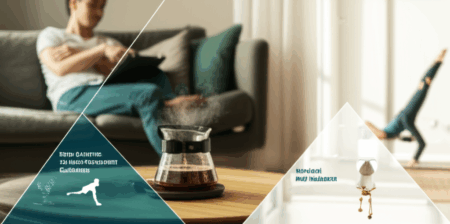For many, the thought of exercise conjures images of grueling effort and dreaded obligation. Yet, for others, physical activity is a source of joy, energy, and fulfillment. What separates these two groups, and can the latter mindset be learned? The good news is, according to experts in neuroscience, psychology, and fitness, you absolutely can train your brain to enjoy exercise, transforming it from a chore into a rewarding habit.
The key lies in understanding how our brains process effort and reward, and then strategically reshaping those associations. Dr. Adam Jameson, a Pharmacist and Precision Health Executive at REVIV, explains that “Repeated physical activity can lead to changes in brain regions associated with reward and motivation.” He adds, “Just like when we learn a new skill, regular physical activity can modify the reward system in our brain, so that exercise feels more pleasurable.” This transformation is largely due to the “feel-good” neurotransmitter, dopamine.

Understanding the Brain’s Reward System and Exercise
Dopamine plays a crucial role in pleasure, motivation, and reward-seeking. When you engage in activities you enjoy, dopamine is released, creating a cycle of motivation, reward, and reinforcement. This chemical helps your brain recognize an experience as pleasurable and encourages you to repeat it. Research suggests that dopamine levels are a critical factor in how people assess the effort a physical task requires and their willingness to undertake future tasks. In essence, the more enjoyable you find an activity, the more motivated you’ll be to continue.
Experts emphasize that our brains are naturally wired for physical movement, with built-in pleasure circuits to promote and reward it. However, negative experiences or a focus on external, often unattainable, goals can corrupt this innate positive exercise psychology.

Expert Strategies to Rewire Your Brain for Exercise Enjoyment
Here are six expert-backed strategies to help you cultivate a positive relationship with exercise and make it a genuinely enjoyable part of your life:
1. Find Your Fun: Prioritize Pleasure Over Punishment
One of the most crucial steps is to shift your perspective from exercise as a punishment to exercise as a source of joy. If an activity isn’t enjoyable or rewarding, experts suggest not forcing yourself to do it, as this can reinforce a negative association.
- Experiment with Activities: Try different forms of movement until you find something you genuinely enjoy. This could be dancing, hiking, swimming, team sports, or rock climbing. A study found that leisure-time activities, like yoga or team sports, tend to improve mood more than obligatory tasks.
- Connect Exercise with Enjoyment: Associate exercise with activities you already love. If you enjoy music, create a custom playlist for your workout or take a dance class. If you like podcasts, listen to them during a walk or bike ride.
- Gamify Your Movement: Turn everyday activities into mini-workouts. Do squats during commercial breaks or turn unloading groceries into an arm workout. This can make movement feel more like a game.
2. Start Small and Build Gradually
Overwhelm is a significant barrier to exercise adherence. Instead of aiming for massive changes, begin with small, consistent, and easily repeatable chunks of activity.
- Bite-Size Routines: Incorporate short bursts of exercise throughout your day. For example, a 5-minute walk daily or just one set of an exercise. This low barrier to entry can create a “pull to do more.”
- Focus on Consistency: In the beginning, consistency is more important than variety or intensity. Doing the same simple workout at the same time and place helps build automaticity. Once the habit is ingrained, you can introduce variation.
- “Just Start” Principle: Action can create motivation. If you’re struggling, commit to just five minutes of movement. This can prime your brain by boosting dopamine, making it easier to continue.
3. Leverage Dopamine and the Reward Cycle
Your brain’s dopamine system is central to building a positive association with exercise. You can actively enhance this.
- Immediate Rewards: After completing a workout, give yourself a small, immediate reward. This could be anything from a special treat to a relaxing bath. This reinforces the positive feeling.
- Visualize Success: Before your workout, visualize yourself successfully completing it and feeling good afterward. Studies show that recalling a positive exercise memory can increase motivation.
- Music Power: Listening to motivational music during a workout can increase enjoyment, endurance, and decrease perceived effort by boosting dopamine.
4. Shift Your Mindset: Identity and Internal Motivation
Changing how you view yourself and your reasons for exercising can profoundly impact adherence.
- Identity Shift: Instead of seeing yourself as “someone trying to get fit,” identify as “someone who enjoys fitness.” Focus on forming habits that align with this new identity.
- Intrinsic Motivation: Prioritize the internal rewards of exercise, such as improved mood, increased energy, stress relief, or a sense of accomplishment, rather than solely focusing on external goals like weight loss. Intrinsic motivation is a stronger predictor of long-term adherence.
- Practice Gratitude: Before a workout, remind yourself why you’re doing it, e.g., “I get to move my body to stay strong and healthy.” Viewing exercise as a privilege, not a burden, can be empowering.
5. Build Habits with Cues and Planning
Strategic planning and environmental cues can turn exercise into an automatic habit, reducing reliance on willpower.
- Cue-Based Habits: Pair exercise with an existing habit. For instance, change into workout clothes immediately after getting home from work, or plan your exercise after brushing your teeth. Visual cues, like laying out your workout clothes, can trigger the routine.
- Consistent Context: Establish a regular time and setting for your workouts. This creates mental and physical associations, making the activity more automatic.
- “If, Then” Planning: Prepare for potential obstacles by creating “if, then” statements. For example, “If I miss my morning workout, then I will do a 20-minute home workout in the evening.” This provides flexibility and boosts self-efficacy.
6. Embrace Social Support and Track Progress
Connecting with others and monitoring your achievements can provide external motivation and reinforce positive feelings.
- Workout Buddies & Groups: Exercising with friends or joining a fitness group can make workouts more enjoyable, increase commitment, and provide accountability.
- Track Small Victories: Don’t just focus on big goals. Track small improvements like increased energy, better sleep, or lifting slightly heavier weights. Visual progress tracking, such as photos or an exercise journal, can be incredibly motivating.
- Celebrate Achievements: Acknowledge your accomplishments, no matter how small. Rewarding milestones reinforces positive behavior and motivates continued effort.
By implementing these strategies, backed by insights from neuroscience and psychology, you can gradually shift your brain’s perception of exercise, making it a source of pleasure and a sustainable habit for life.







